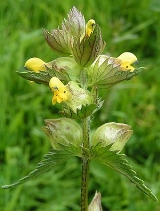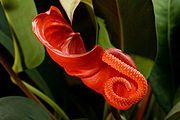
Bract
Encyclopedia

Botany
Botany, plant science, or plant biology is a branch of biology that involves the scientific study of plant life. Traditionally, botany also included the study of fungi, algae and viruses...
, a bract is a modified or specialized leaf
Leaf
A leaf is an organ of a vascular plant, as defined in botanical terms, and in particular in plant morphology. Foliage is a mass noun that refers to leaves as a feature of plants....
, especially one associated with a reproductive structure such as a flower
Flower
A flower, sometimes known as a bloom or blossom, is the reproductive structure found in flowering plants . The biological function of a flower is to effect reproduction, usually by providing a mechanism for the union of sperm with eggs...
, inflorescence
Inflorescence
An inflorescence is a group or cluster of flowers arranged on a stem that is composed of a main branch or a complicated arrangement of branches. Strictly, it is the part of the shoot of seed plants where flowers are formed and which is accordingly modified...
axis, or cone scale. Bracts are often (but not always) different from foliage leaves. They may be smaller, larger, or of a different color, shape, or texture. Typically, they also look different from the parts of the flower, such as the petals and/or sepals.
Some bracts are brightly colored and serve the function of attracting pollinators, either together with the perianth
Perianth
The term perianth has two similar but separate meanings in botany:* In flowering plants, the perianth are the outer, sterile whorls of a flower...
or instead of it. Examples of this type of bract include Euphorbia pulcherrima (poinsettia) and Bougainvillea
Bougainvillea
Bougainvillea is a genus of flowering plants native to South America from Brazil west to Peru and south to southern Argentina . Different authors accept between four and 18 species in the genus...
: both of these have large colourful bracts surrounding much smaller, less colourful flowers.
In grasses, each floret (flower) is enclosed in a pair of papery bracts, called the lemma (lower bract) and palea (upper bract), while each spikelet (group of florets) has a further pair of bracts at its base called glumes. These bracts form the chaff
Chaff
Chaff is the dry, scaly protective casings of the seeds of cereal grain, or similar fine, dry, scaly plant material such as scaly parts of flowers, or finely chopped straw...
removed from cereal
Cereal
Cereals are grasses cultivated for the edible components of their grain , composed of the endosperm, germ, and bran...
grain during threshing
Threshing
Threshing is the process of loosening the edible part of cereal grain from the scaly, inedible chaff that surrounds it. It is the step in grain preparation after harvesting and before winnowing, which separates the loosened chaff from the grain...
and winnowing.
Bats may detect acoustic signals from dish shaped bracts such as those of Marcgravia evenia
Marcgravia evenia
Marcgravia evenia is a species of plant in the Marcgraviaceae family, within this family it belongs to the Galetae group, which is characterized by a long inflorescence axis and boat shaped nectaries . This plant that has evolved bowl shaped leaves which act as reflectors for a bat's biosonar...
.
A prophyll is a leaf-like structure, such as a bracteole, subtending a single flower or pedicel. The term can also mean the lower bract on a peduncle.
The frequently showy pair of bracts of Euphorbia species in subgenus Lacanthis are the cyathophylls.
Bracts subtend the cone scales in the seed cones of many conifers, and in some cases, such as Pseudotsuga, they extend beyond the cone scales.
Bracteole
A small bract is called a bracteole or bractlet. Technically this is any bract that arises on a pedicel instead of subtending it.Involucral bracts

Apiaceae
The Apiaceae , commonly known as carrot or parsley family, is a group of mostly aromatic plants with hollow stems. The family is large, with more than 3,700 species spread across 434 genera, it is the sixteenth largest family of flowering plants...
, Asteraceae
Asteraceae
The Asteraceae or Compositae , is an exceedingly large and widespread family of vascular plants. The group has more than 22,750 currently accepted species, spread across 1620 genera and 12 subfamilies...
, Dipsacaceae
Dipsacaceae
The Dipsacaceae, or teasel family, of the order Dipsacales contains 350 species of perennial or biennial herbs and shrubs in eleven genera. Native to most temperate climates, they are found in Europe, Asia and Africa...
and Polygonaceae
Polygonaceae
Polygonaceae is a family of flowering plants known informally as the "knotweed family" or "smartweed family"— "buckwheat family" in the United States. The name is based on the genus Polygonum and was first used by Antoine Laurent de Jussieu in 1789 in his book, Genera Plantarum. The name refers...
. Each flower in an inflorescence may have its own whorl of bracts, in this case called an involucel. In this case they may be called chaff, paleas, or receptacular bracts and are usually minute scales or bristles. Many asteraceous
Asteraceae
The Asteraceae or Compositae , is an exceedingly large and widespread family of vascular plants. The group has more than 22,750 currently accepted species, spread across 1620 genera and 12 subfamilies...
plants have bracts at the base of each inflorescence.
The term involucre is also used for a highly conspicuous bract
Bract
In botany, a bract is a modified or specialized leaf, especially one associated with a reproductive structure such as a flower, inflorescence axis, or cone scale. Bracts are often different from foliage leaves. They may be smaller, larger, or of a different color, shape, or texture...
or bract pair at the base of an inflorescence
Inflorescence
An inflorescence is a group or cluster of flowers arranged on a stem that is composed of a main branch or a complicated arrangement of branches. Strictly, it is the part of the shoot of seed plants where flowers are formed and which is accordingly modified...
. In the family Betulaceae
Betulaceae
Betulaceae, or the Birch Family, includes six genera of deciduous nut-bearing trees and shrubs, including the birches, alders, hazels, hornbeams and hop-hornbeams, numbering about 130 species...
, notably in the genera Carpinus
Hornbeam
Hornbeams are relatively small hardwood trees in the genus Carpinus . Though some botanists grouped them with the hazels and hop-hornbeams in a segregate family, Corylaceae, modern botanists place the hornbeams in the birch subfamily Coryloideae...
and Corylus
Hazel
The hazels are a genus of deciduous trees and large shrubs native to the temperate northern hemisphere. The genus is usually placed in the birch family Betulaceae, though some botanists split the hazels into a separate family Corylaceae.They have simple, rounded leaves with double-serrate margins...
, the involucre is a leafy structure that protects the developing nuts.
Epicalyx
An epicalyx, which forms an additional whorl around the calyxCalyx
-Anatomy:*structural components of the mammalian kidney** Major calyx** Minor calyx* Calyx of Held, a large synapse in the auditory brainstem structure* Calyx , the crown of a crinoid-Other:* Calyx , a UK producer of drum and bass...
of a single flower, is a modification of bracteoles In other words, the epicalyx is a group of bracts resembling a calyx or bracteoles forming a whorl outer to the calyx. It is a calyx-like extra whorl of floral appendages. Each individual segment of the epicalyx is called an episepal because they resemble the sepals.. They are present in family Malvaceae
Malvaceae
Malvaceae, or the mallow family, is a family of flowering plants containing over 200 genera with close to 2,300 species. Judd & al. Well known members of this family include okra, jute and cacao...
, the Hibiscus family. Fragaria (strawberries) may or may not have an epicalyx.
Spathe

Arecaceae
Arecaceae or Palmae , are a family of flowering plants, the only family in the monocot order Arecales. There are roughly 202 currently known genera with around 2600 species, most of which are restricted to tropical, subtropical, and warm temperate climates...
s, arum
Arum
Arum is a genus of about 25 species of flowering plants in the family Araceae, native to Europe, northern Africa, and western Asia, with the highest species diversity in the Mediterranean region....
s, and dayflowers. In many arums (Araceae
Araceae
Araceae are a family of monocotyledonous flowering plants in which flowers are borne on a type of inflorescence called a spadix. The spadix is usually accompanied by, and sometimes partially enclosed in, a spathe or leaf-like bract. Also known as the Arum family, members are often colloquially...
family), the spathe is petal-like, attracting pollinators to the flowers arranged on a type of spike called a spadix
Spadix
In botany, a spadix is a type of spike inflorescence having small flowers borne on a fleshy stem. Spadix are typical of the Family Araceae known as arums or aroids...
.

